Shared Cycling Demand Prediction during COVID-19 Combined with Urban Computing and Spatiotemporal Residual Network
Abstract
:1. Introduction
2. Data and Analysis
2.1. Data and Study Area
2.2. Preliminary Analysis of Spatial-Temporal Data
- (1)
- Spatial distribution characteristics
- (2)
- Temporal distribution characteristics
- (3)
- Other urban factors’ characteristics
3. Methodology
3.1. Definition of Time Step
3.2. Problem
3.3. USTARN Model
- (1)
- Data processing
- (2)
- The first prediction model
- (3)
- The second prediction model
- (4)
- The final prediction
4. Experiments
4.1. Data Set Preprocessing
4.2. Settings
4.3. USTARN Experiments
4.4. Baselines
- (1)
- S-LSTM [27]: A long-term and short-term prediction model based on time series segmentation. S-LSTM adds the time series segmentation module on the basis of a recurrent neural network to improve the prediction effect of the time series.
- (2)
- BiLSTM [26]: A long-term and short-term prediction model combining forward LSTM and backward LSTM. Compared with the basic LSTM, BiLSTM can better capture the dependency of two-way information.
- (3)
- CNN [36]: the size of a convolution kernel is 3 × 3 the size of a convolutional neural network.
4.5. Comparison and Result Analysis
- (1)
- USTARN experiments
- (2)
- Baseline experiments
5. Discussion
6. Conclusions
Author Contributions
Funding
Institutional Review Board Statement
Informed Consent Statement
Data Availability Statement
Acknowledgments
Conflicts of Interest
Abbreviations
| COVID-19 | Corona Virus Disease 2019 |
| DBSCAN | Density-based spatial clustering of applications with noise |
| GPS | Global Positioning System |
| CDC | Centers for Disease Control |
| MAPE | Mean Absolute Percentage Error |
References
- Zhang, J.P.; Wang, F.Y.; Wang, K.F.; Lin, W.H.; Xu, X.; Chen, C. Data-Driven Intelligent Transportation Systems: A Survey. IEEE Trans. Intell. Transp. Syst. 2011, 12, 1624–1639. [Google Scholar] [CrossRef]
- Dai, G.N.; Hu, X.Y.; Ge, Y.M.; Ning, Z.Q.; Liu, Y.B. Attention based simplified deep residual network for citywide crowd flows prediction. Front. Comput. Sci. 2021, 15, 152317. [Google Scholar] [CrossRef]
- Hui, Y.; Liao, J.M.; Tang, L.; Xie, Y.K.; Li, J. Travel behavior and preference using bike sharing during the pandemic. Urban Transp. China 2020, 18, 100–109. [Google Scholar] [CrossRef]
- Beijing Comprehensive Transportation Development Research Institute of Beijing Jiaotong University. Beijing Transportation Blue Book: Beijing Transportation Development Report (2021); Social Science Literature Press: Beijing, China, 2022; ISBN 9787520195560. [Google Scholar]
- Fu, X.M.; Juan, Z.C. Unraveling mobility pattern of dockless bike-sharing use in Shanghai. J. Transp. Syst. Eng. Inf. Technol. 2020, 20, 219–226. [Google Scholar] [CrossRef]
- Zhao, X.F.; Hu, C.Y.; Liu, Z.; Meng, Y.Y. Weighted dynamic time warping for grid-based travel-demand-pattern clustering: Case study of Beijing bicycle-sharing system. ISPRS Int. J. Geo-Inf. 2019, 8, 281. [Google Scholar] [CrossRef] [Green Version]
- Gao, Y.; Song, C.; Shu, H.; Pei, T. Spatial-temporal characteristics of source and sink points of Mobikes in Beijing and its scheduling strategy. J. Geo-Inf. Sci. 2018, 20, 1123–1138. [Google Scholar] [CrossRef]
- Du, Y.C.; Deng, F.W.; Liao, F.X. A model framework for discovering the spatio-temporal usage patterns of public free-floating bike-sharing system. Transp. Res. Part C 2019, 103, 39–55. [Google Scholar] [CrossRef]
- Zhang, Y.P.; Lin, D.; Mi, Z.F. Electric fence planning for dockless bike- sharing services. J. Clean. Prod. 2019, 206, 383–393. [Google Scholar] [CrossRef]
- Yu, J.J.; Ji, Y.J.; Yi, C.Y.; Liu, Y. Estimating model for urban carrying capacity on bike- sharing. J. Cent. South Univ. 2021, 28, 1775–1785. [Google Scholar] [CrossRef]
- Hua, M.Z.; Chen, X.W.; Zheng, S.J.; Chen, L.; Chen, J.X. Estimating the parking demand of free- floating bike sharing: A journeydata-based study of Nanjing, China. J. Clean. Prod. 2020, 244, 118764. [Google Scholar] [CrossRef]
- Wang, Y.C.; Douglas, M.; Hazen, B. Diffusion of public bicycle systems: Investigating influences of users perceived risk and switching intention. Transp. Res. Part A 2021, 143, 1–13. [Google Scholar] [CrossRef]
- Sun, Q.P.; Zeng, K.B.; Zhang, K.Q.; Yang, Y.C.; Zhang, S.X. Spatiotemporal travel patterns and demand prediction of shared bikes in Beijing. J. Transp. Syst. Eng. Inf. Technol. 2022, 22, 332–338. [Google Scholar] [CrossRef]
- Zhang, Y.C.; Fricker, J.D. Quantifying the impact of COVID-19 on non-motorized transportation: A Bayesian structural time series model. Transp. Policy 2021, 103, 11–20. [Google Scholar] [CrossRef]
- El-Assi, W.; Mahmoud, M.S.; Habib, K.N. Effects of built environment and weather on bike sharing demand: A station level analysis of commercial bike sharing in Toronto. Transportation 2017, 44, 589–613. [Google Scholar] [CrossRef]
- Zhang, Y.; Thomas, T.; Brussel, M.; Maarseveen, M.V. Exploring the impact of built environment factors on the use of public bikes at bike stations: Case study in Zhongshan, China. J. Transp. Geogr. 2017, 58, 59–70. [Google Scholar] [CrossRef]
- Guidon, S.; Becker, H.; Dediu, H.; Axhausen, K.W. Electric Bicycle-Sharing: A New Competitor in the Urban Transportation Market? An Empirical Analysis of Transaction Data. Transp. Res. Rec. 2019, 2673, 1–12. [Google Scholar] [CrossRef]
- Kapuku, C.; Kho, S.Y.; Kim, D.K.; Cho, S.H. Modeling the competitiveness of a bike- sharing system using bicycle GPS and transit smartcard data. Transp. Lett. Int. J. Transp. Res. 2020, 1, 347–351. [Google Scholar] [CrossRef]
- Yang, Z.J.; Ma, Q.Y. Evolutionary game analysis of shared bike cyclists’ opportunistic behaviour. J. Ind. Eng. 2020, 34, 104–111. [Google Scholar] [CrossRef]
- Feng, S.J.; Chen, H.; Du, C.; Li, J. A hierarchical demand prediction method with station clustering for bike sharing system. In Proceedings of the 2018 IEEE Third International Conference on Data Science in Cyberspace (DSC), Guangzhou, China, 18–21 June 2018; pp. 829–836. [Google Scholar]
- Peng, Y.; Zhang, W.; Wan, F. Demand prediction for station clusters in bike sharing system. Comput. Appl. Softw. 2021, 38, 92–98, 110. [Google Scholar] [CrossRef]
- Huang, F.H.; Qiao, S.J.; Peng, J.; Guo, B. A Bimodal Gaussian Inhomogeneous Poisson Algorithm for Bike Number Prediction in a Bike-Sharing System. IEEE Trans. Intell. Transp. Syst. 2019, 20, 1–10. [Google Scholar] [CrossRef]
- Li, X.H.; Zhang, X.Y.; Cheng, C.; Yang, C.; Wang, W. Dynamic repositioning model for free-floating bike-sharing system considering shifting demand. J. Transp. Syst. Eng. Inf. Technol. 2020, 20, 182–189. [Google Scholar] [CrossRef]
- Qiao, S.J.; Han, N.; Yue, K.; Yi, Y.G.; Huang, F.L.; Yuan, C.A.; Ding, P.; Gutierrez, L.A. Shared-bike demand prediction model based on station clustering. J. Softw. 2022, 33, 1451–1476. [Google Scholar] [CrossRef]
- Ashqar, H.I.; Elhenawy, M.; Almannaa, M.H.; Ghanem, A.; Rakha, H.A.; House, L. Modeling bike availability in a bike-sharing system using machine learning. In Proceedings of the 2017 5th IEEE International Conference on Models and Technologies for Intelligent Transportation Systems (MT-ITS), Naples, Italy, 26–28 June 2017; pp. 374–378. [Google Scholar]
- Xu, C.C.; Ji, J.Y.; Liu, P. The station-free sharing bike demand forecasting with a deep learning approach and large-scale datasets. Transp. Res. Part C 2018, 95, 47–60. [Google Scholar] [CrossRef]
- Jiang, X.; Bai, L.B.; Lou, X.Y.; Li, M.; Liu, H. Usage patterns identification and flow prediction of bike-sharing system based on multiscale spatiotemporal clustering. J. Geo-Inf. Sci. 2022, 24, 1047–1060. [Google Scholar] [CrossRef]
- Julia, P.; Przemyslaw, A.G.; Ryota, K.; Carlos, C.; Philippe, C.-M.; Karl, A. Predicting the success of online petitions leveraging multidimensional time-series. In Proceedings of the WWW ’17: Proceedings of the 26th International Conference on World Wide Web, Perth, Australia, 3–7 April 2017; Volume 5, pp. 755–764. [Google Scholar] [CrossRef] [Green Version]
- Qiao, S.J.; Han, N.; Wang, J.F.; Li, R.H.; Gutierrez, L.A.; Wu, X.D. Predicting Long-Term Trajectories of Connected Vehicles via the Prefix-Projection Technique. IEEE Trans. Intell. Transp. Syst. 2018, 19, 2305–2315. [Google Scholar] [CrossRef]
- Chai, D.; Wang, L.Y.; Yang, Q. Bike flow prediction with multi-graph convolutional networks. In Proceedings of the 26th ACM SIGSPATIAL International Conference on Advances in Geographic Information Systems—SIGSPATIAL ’18, Kunming, China, 6 November 2018; pp. 397–400. [Google Scholar]
- Zhang, J.B.; Zheng, Y.; Qi, D.K. Deep Spatio-Temporal Residual Networks for Citywide Crowd Flows Prediction. In Proceedings of the Thirty-First AAAI Conference on Artificial Intelligence (AAAI-17), San Francisco, CA, USA, 4–9 February 2017; pp. 1655–1661. [Google Scholar]
- Guo, S.N.; Lin, Y.F.; Feng, N.; Song, C.; Wan, H.Y. Attention Based Spatial-Temporal Graph Convolutional Networks for Traffic Flow Forecasting. In Proceedings of the AAAI Conference on Artificial Intelligence 2019, Honolulu, HI, USA, 27 January–1 February 2019; pp. 922–929. [Google Scholar]
- Liu, Y.C.; Li, Z.P.; Lv, C.P.; Zhang, T.; Liu, Y. Network-wide traffic flow prediction research based on DTW algorithm spatial-temporal graph convolution. J. Transp. Syst. Eng. Inf. Technol. 2022, 22, 1–17. Available online: https://kns.cnki.net/kcms/detail/11.4520.U.20220412.1314.010.html (accessed on 13 April 2022).
- Zeng, J.C.; Shao, M.H.; Sun, L.J.; Lu, C. Traffic prediction and congestion control based on directed graph convolution neural network. China J. Highw. Transp. 2021, 34, 239–248. [Google Scholar] [CrossRef]
- Kingma, D.; Ba, J. Adam: A method for stochastic optimization. In Proceedings of the 3rd International Conference on Learning Representations (ICLR 2015), San Diego, CA, USA, 7–9 May 2015; pp. 1–15. [Google Scholar]
- Lin, L.; He, Z.B.; Peeta, S. Predicting station-level hourly demand in a large-scale bike-sharing network: A graph convolutional neural network approach. Transp. Res. Part C 2018, 97, 258–276. [Google Scholar] [CrossRef] [Green Version]
- Jaber, A.; Baker, L.A.; Csonka, B. The Influence of Public Transportation Stops on Bike-Sharing Destination Trips: Spatial Analysis of Budapest City. Future Transp. 2022, 2, 688–697. [Google Scholar] [CrossRef]
- Turoń, K. Complaints Analysis as an Opportunity to Counteract Social Transport Exclusion in Shared Mobility Systems. Smart Cities 2022, 5, 875–888. [Google Scholar] [CrossRef]
- Yang, Z.D.; Hu, J.; Shu, Y.C.; Cheng, P.; Chen, J.M.; Moscibroda, T. Mobility Modeling and Prediction in Bike-Sharing Systems. In Proceedings of the Mobile Systems, Applications, and Services 2016, Singapore, 25–30 June 2016; pp. 165–178. [Google Scholar]
- Turoń, K.; Czech, P. The Concept of Rules and Recommendations for Riding Shared and Private E-Scooters in the Road Network in the Light of Global Problems. Sci. Tech. Conf. Transp. Syst. Theory Pract. 2019, 1083, 275–284. [Google Scholar] [CrossRef]
- Turoń, K. Soical Barriers and Transportation Social Exclusion Issues in Creating Sustainable Car-Sharing Syetems. Entrep. Sustain. Issues 2021, 9, 10–22. [Google Scholar] [CrossRef]
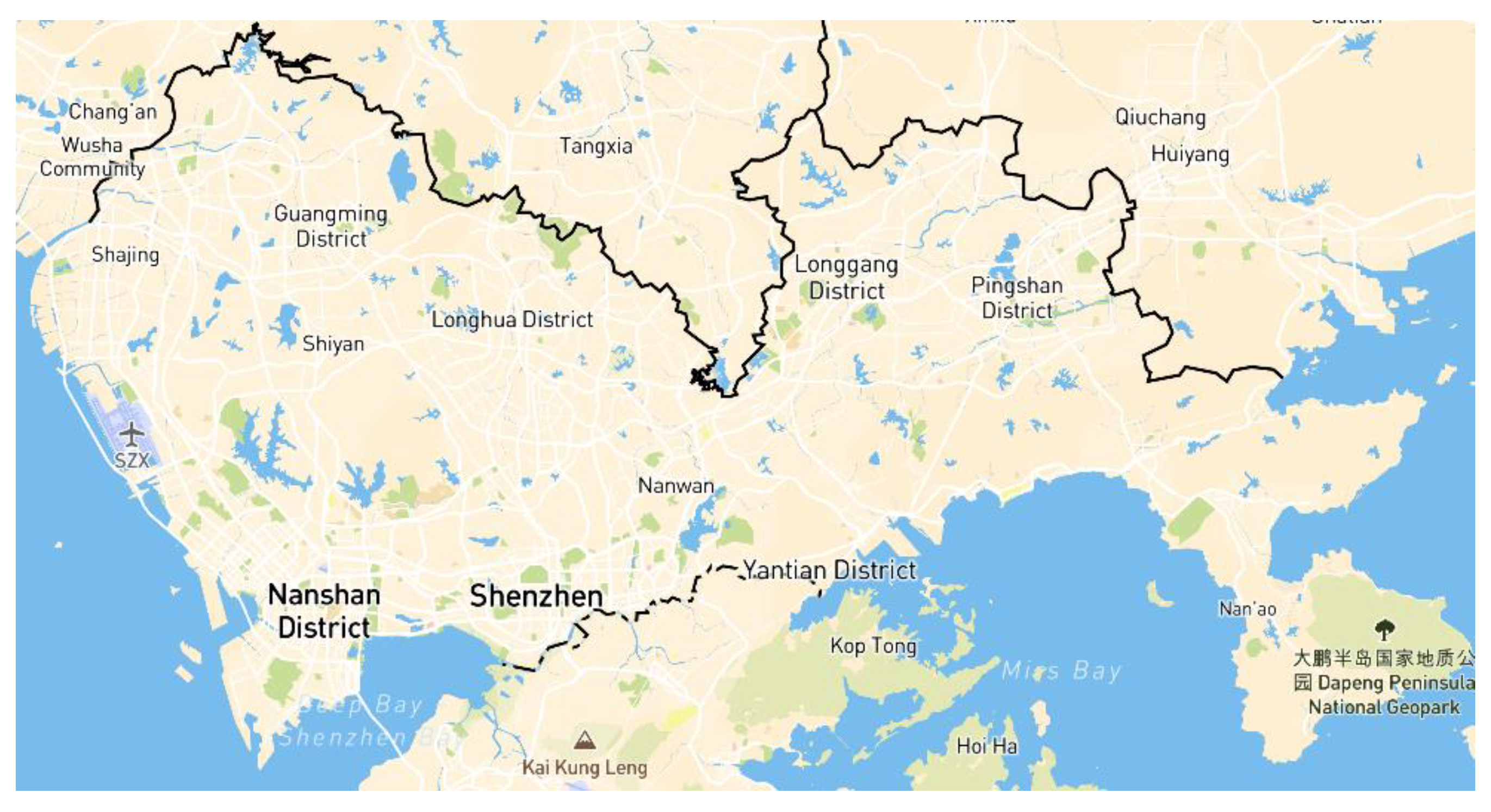

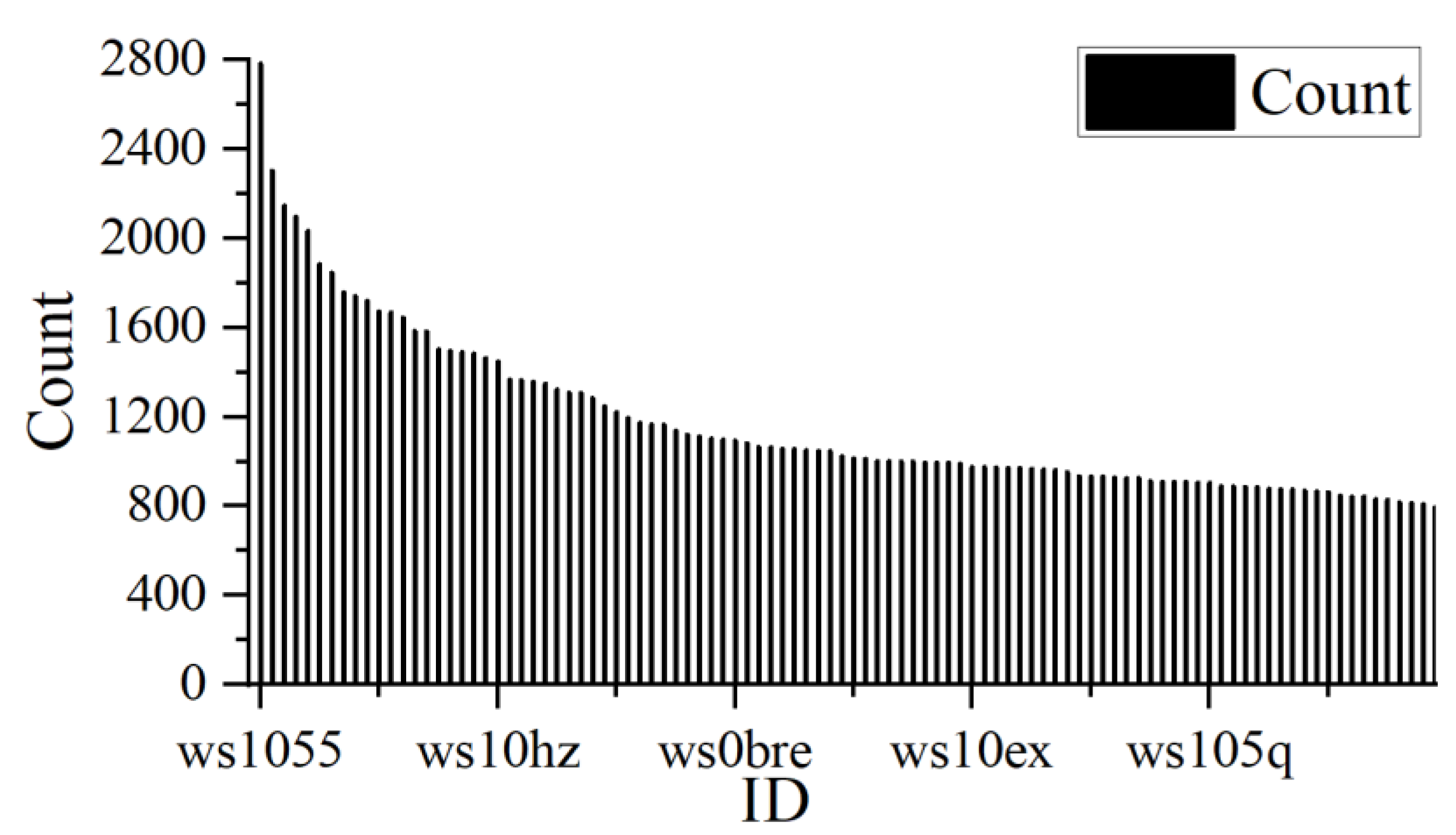
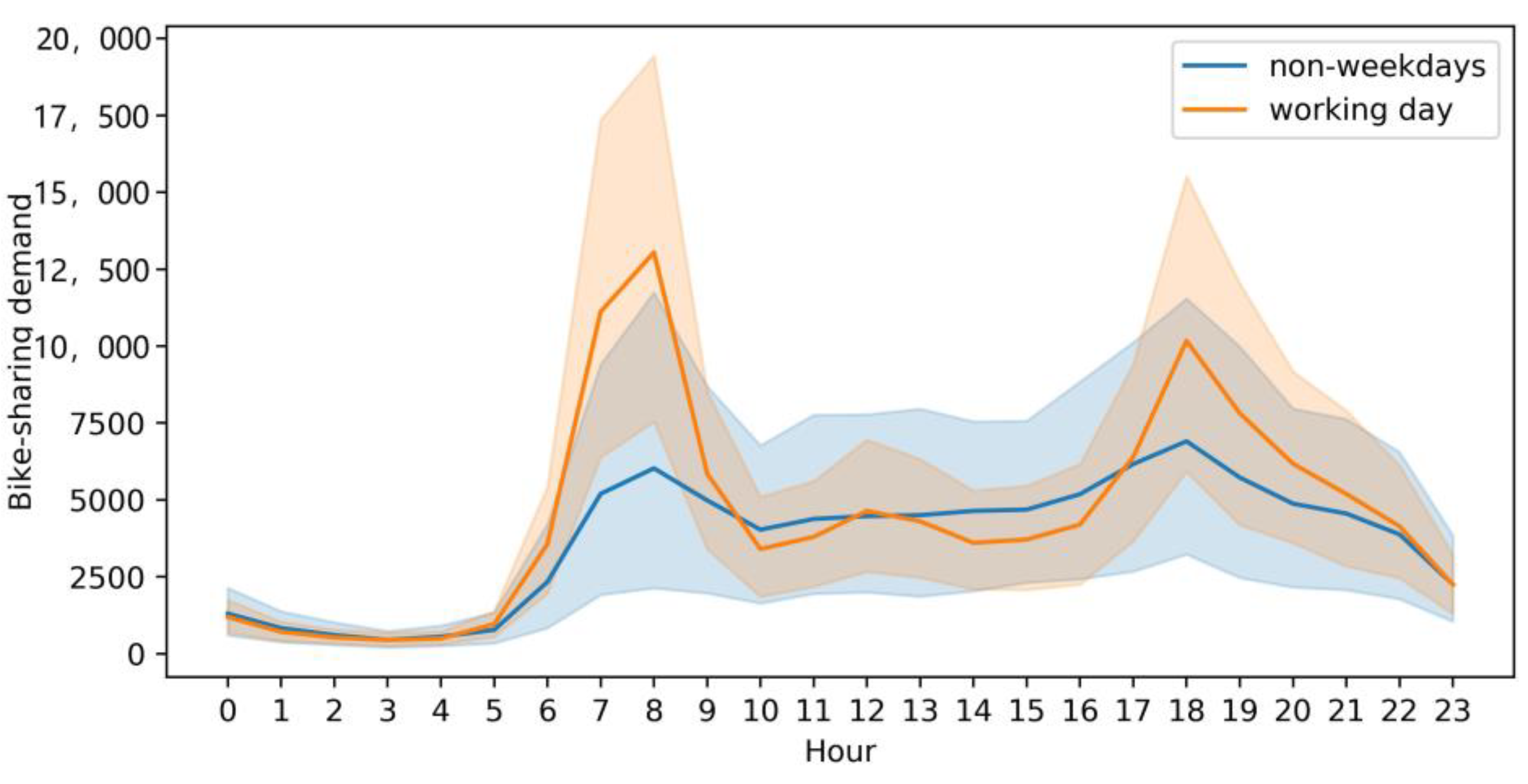
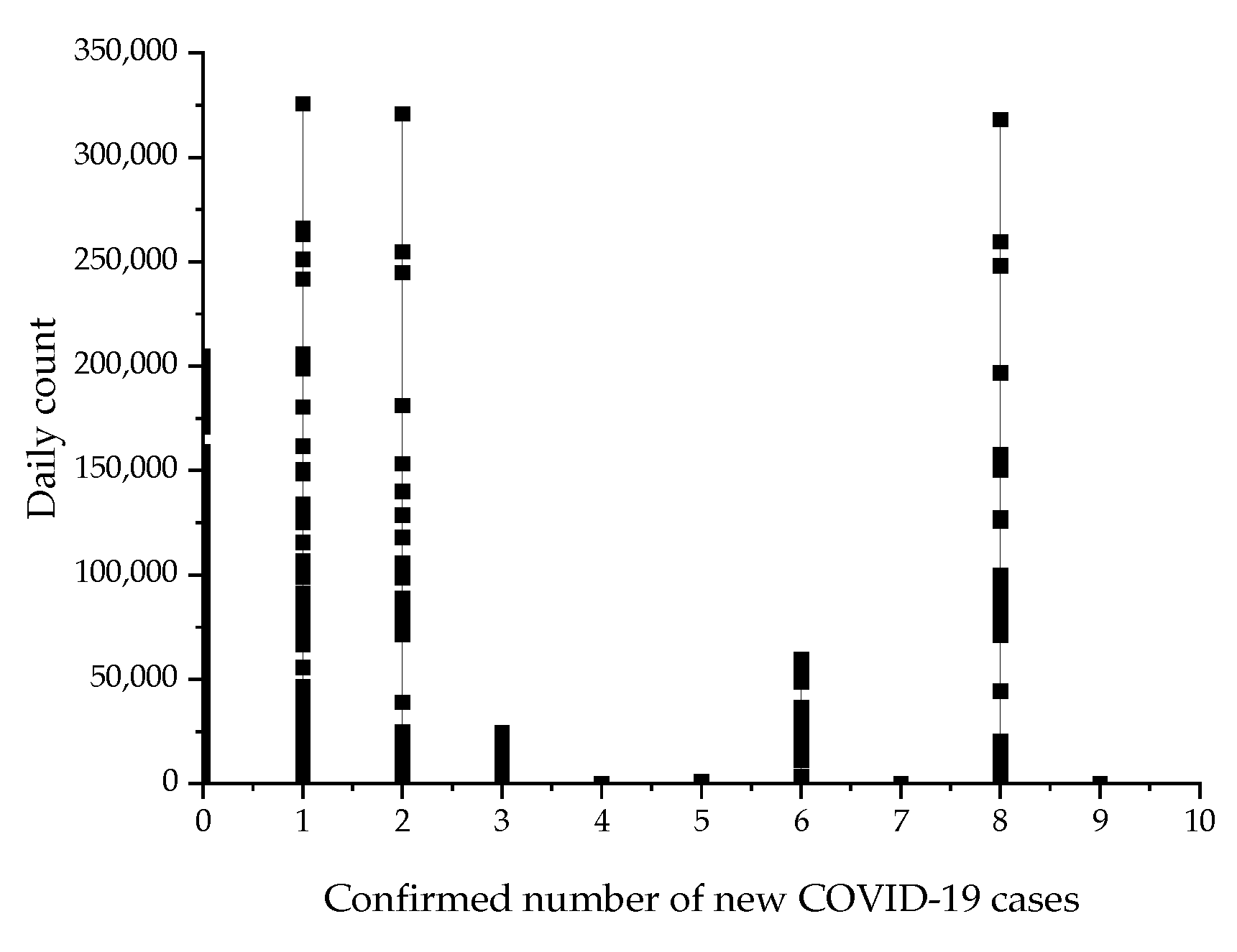

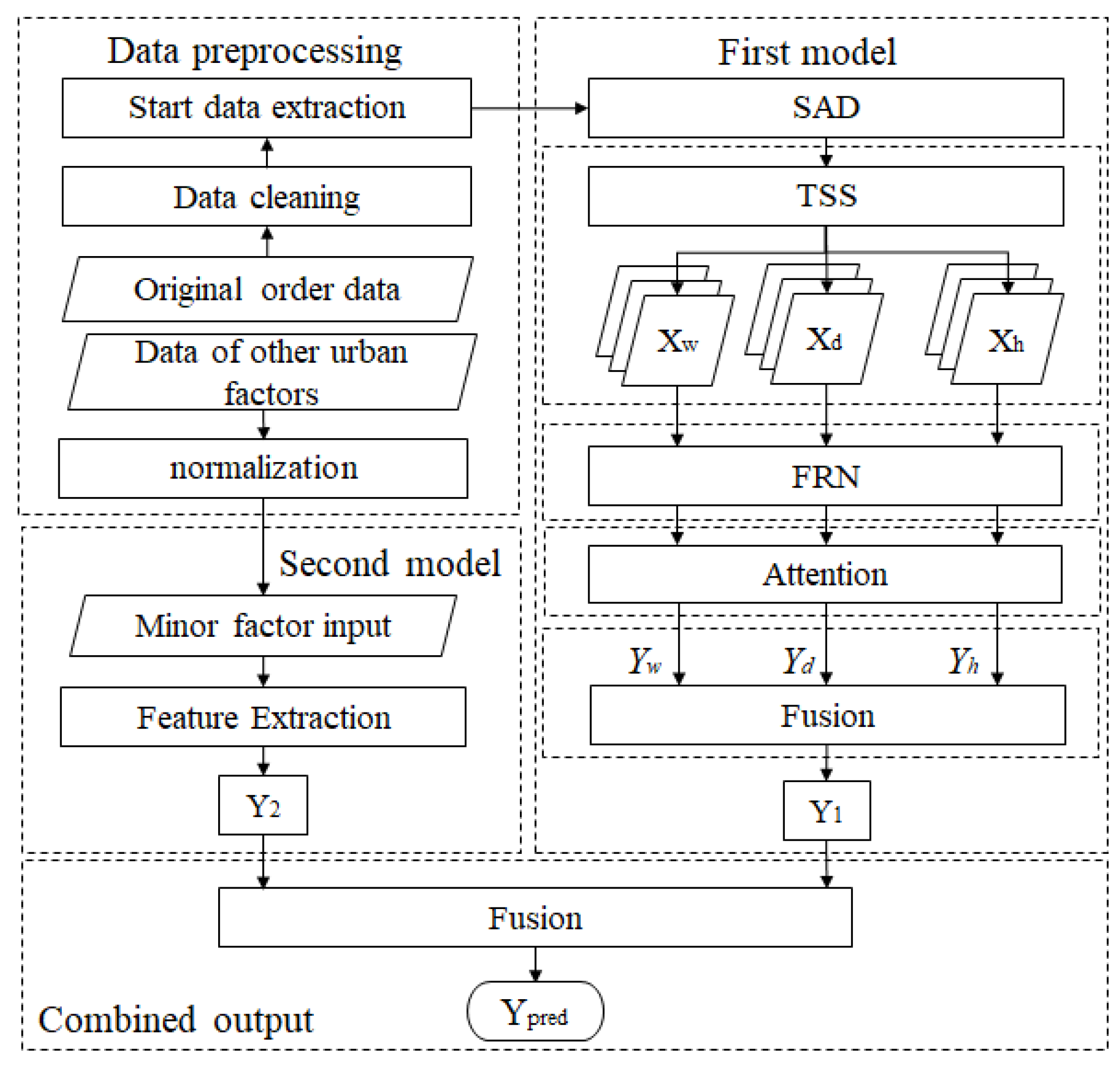
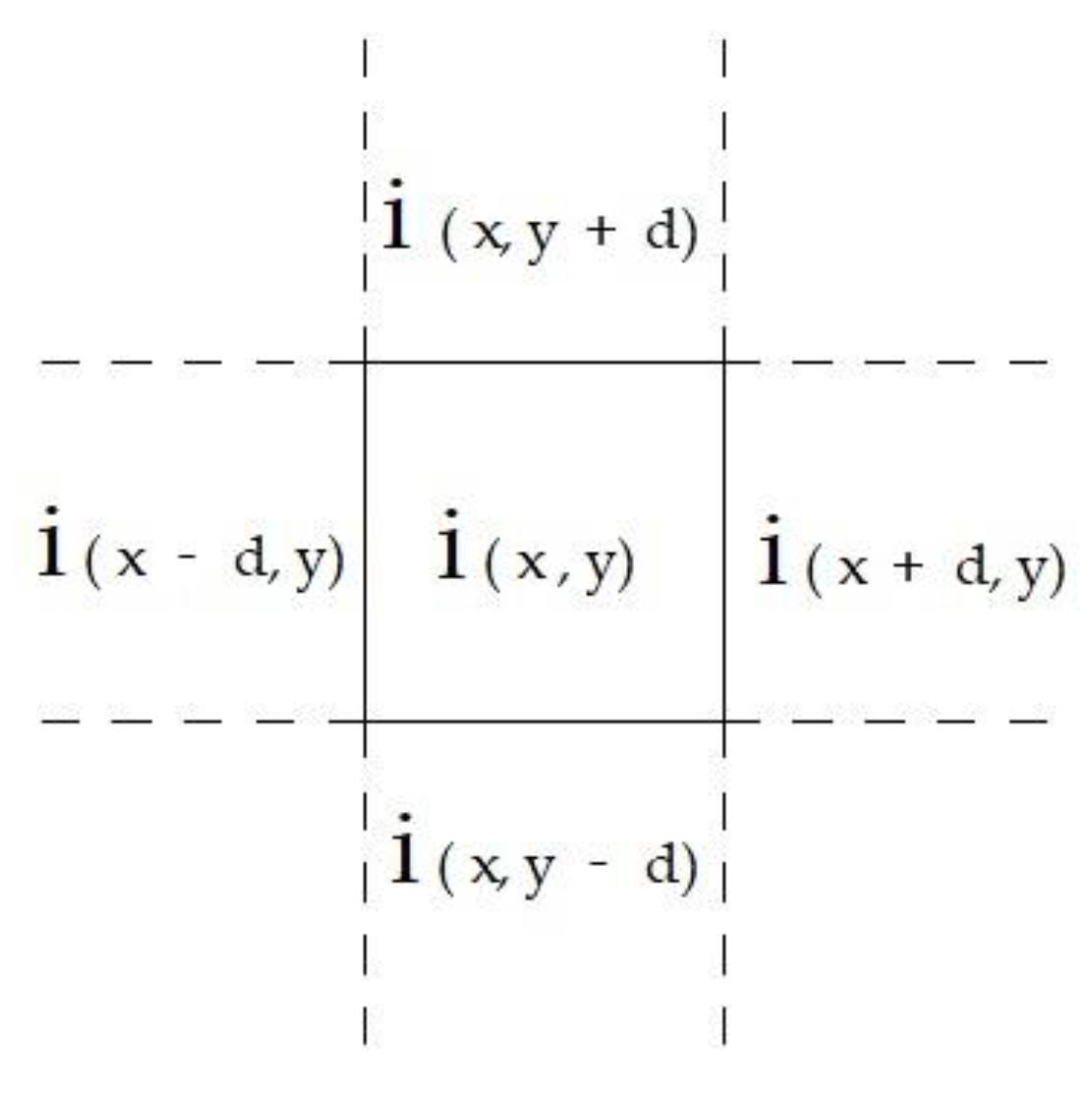


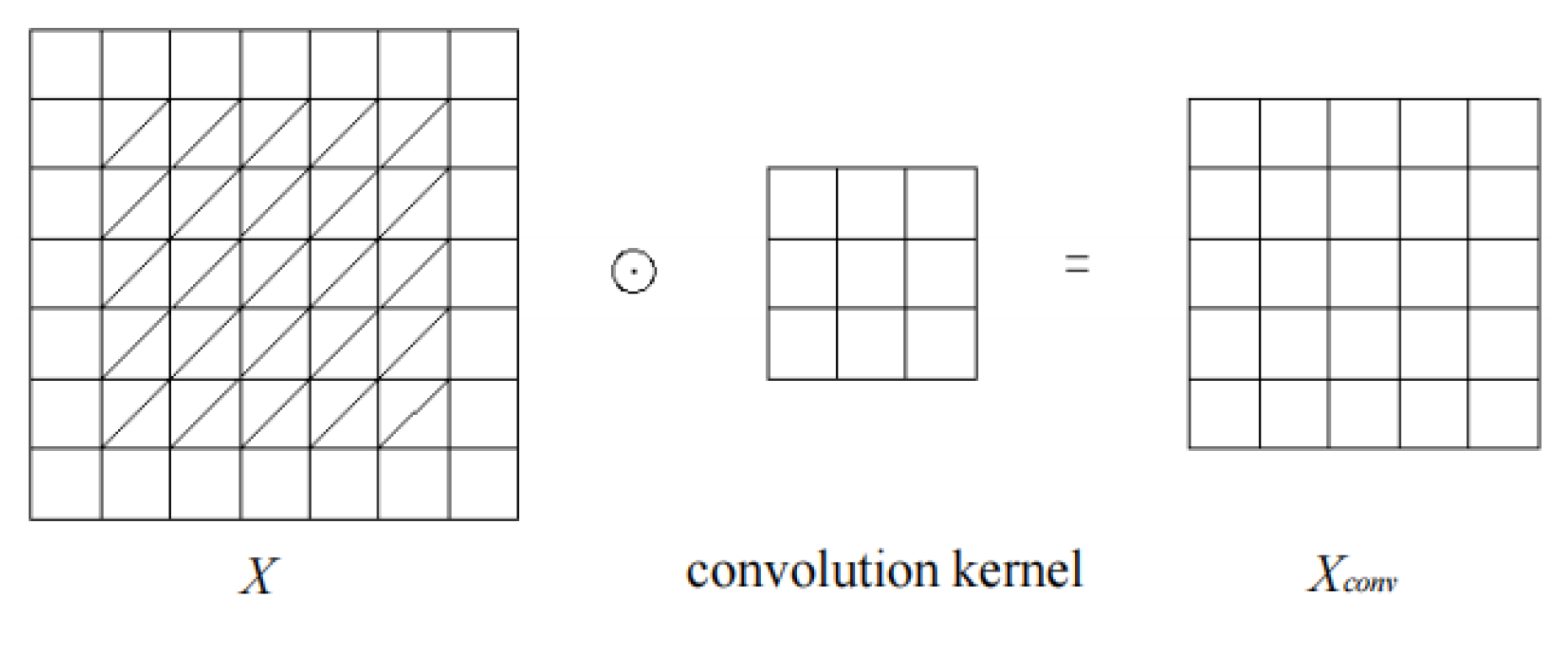
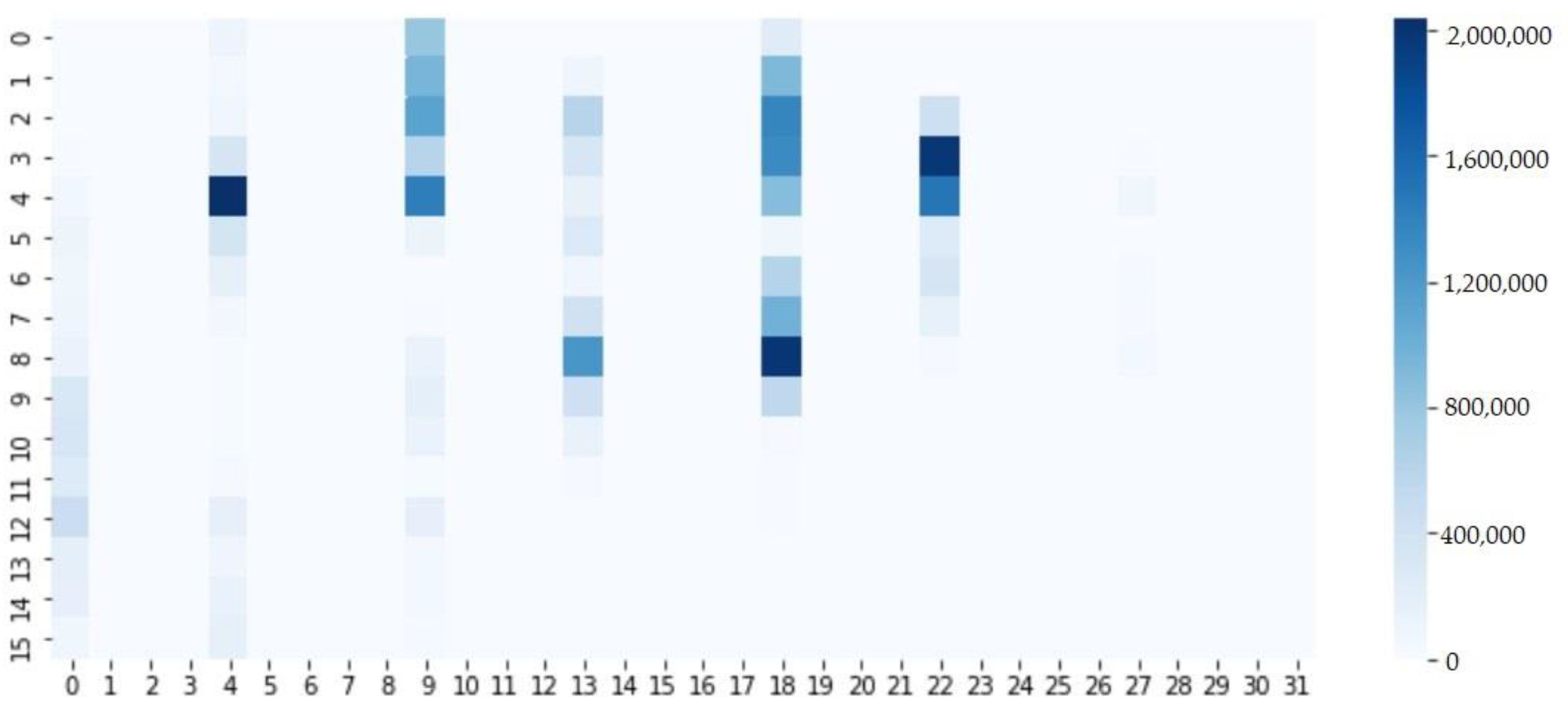
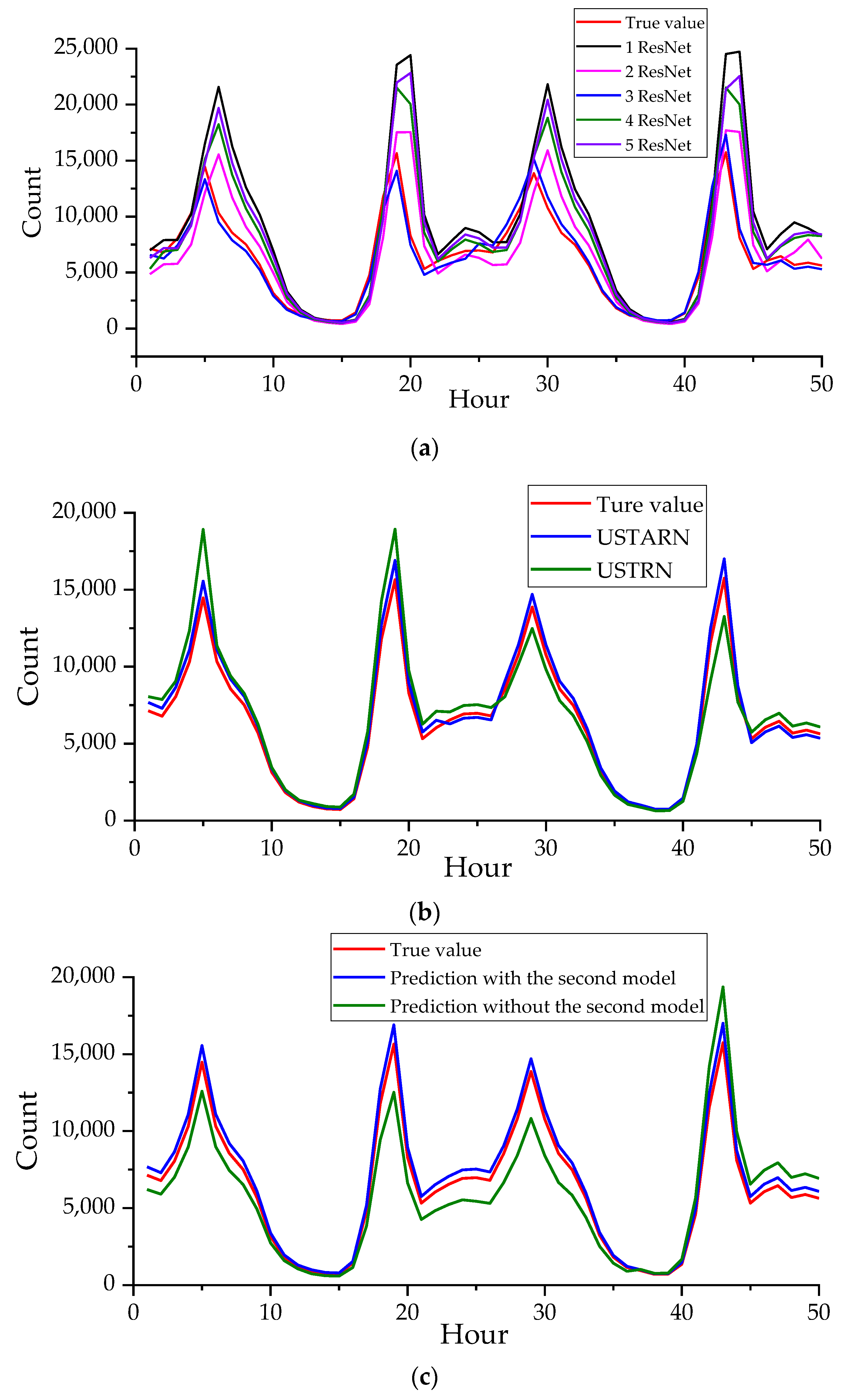

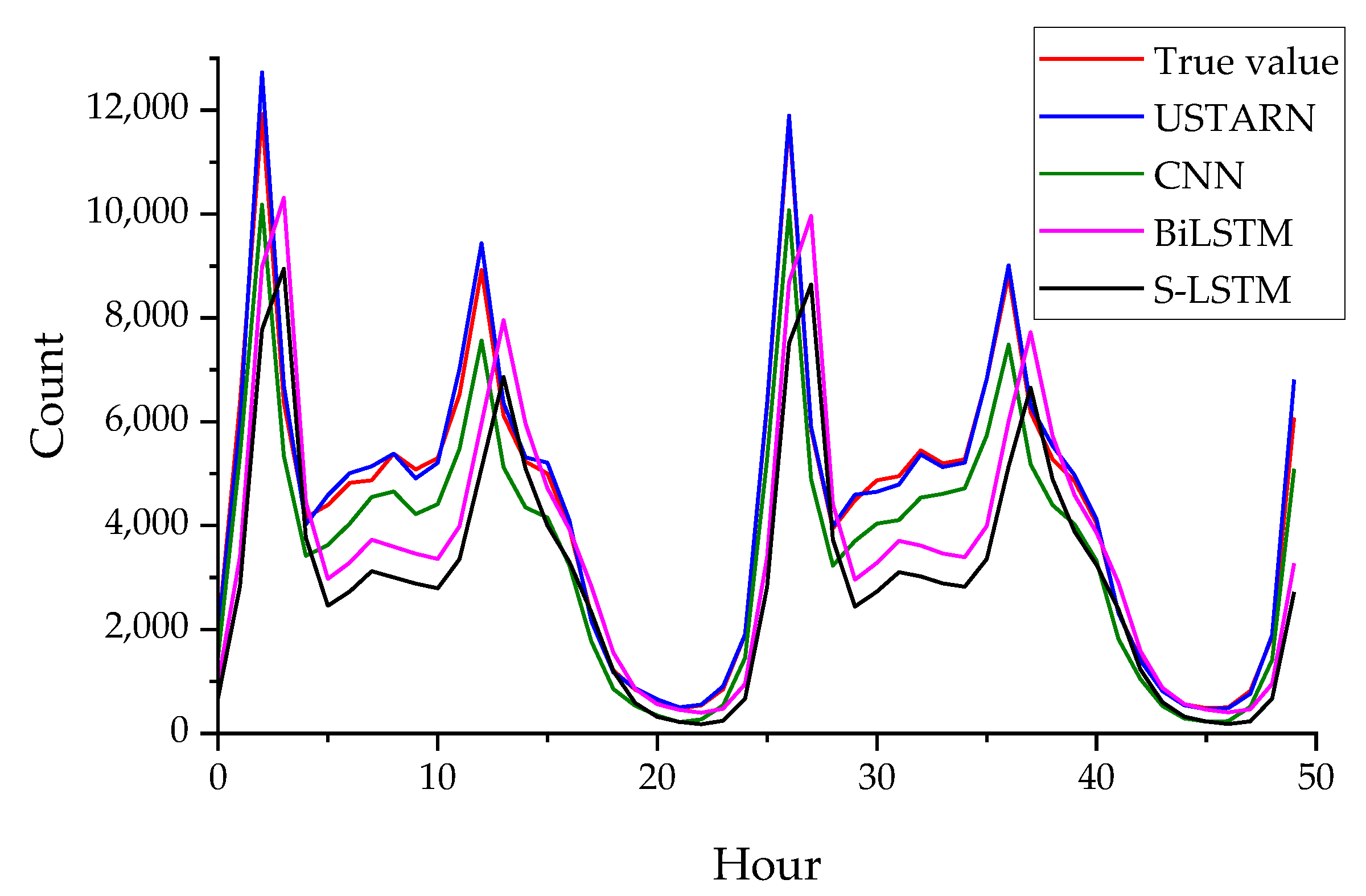
| Time Stamp | The Confirmed Cases | The Newly Confirmed Cases | The Maximum Temperature | The Minimum Temperature | Weather | Wind Speed | Whether the Day Is a Working Day |
|---|---|---|---|---|---|---|---|
| 2020/1/30 9:00 | 0.11752 | 1 | 0.33333 | 0.21739 | 0.25 | 0.09091 | 0 |
| 2020/2/2 13:00 | 0.22395 | 0.34906 | 0.46667 | 0.30435 | 0 | 0.04545 | 0 |
| 2020/2/5 13:00 | 0.33592 | 0.04245 | 0.43333 | 0.39131 | 0.25 | 0 | 1 |
| 2021/2/19 14:00 | 0.06652 | 0.07547 | 0.53333 | 0.43478 | 0 | 0.04545 | 1 |
| 2021/4/3 8:00 | 0.64302 | 0 | 0.8 | 0.78261 | 0 | 0 | 0 |
| Model | MAPE |
|---|---|
| USTARN of one residual network layer | 25.13% |
| USTARN of two residual network layers | 8.98% |
| USTARN of three residual network layers | 7.89% |
| USTARN of four residual network layers | 15.68% |
| USTARN of five residual network layers | 17.21% |
| USTRN of three residual network layers | 16.35% |
| Two-residual-network-layer STARN without the second model | 15.03% |
| Model | MAPE |
|---|---|
| S-LSTM | 23.58% |
| BiLSTM | 23.16% |
| CNN | 15.61% |
| USTARN | 7.89% |
Publisher’s Note: MDPI stays neutral with regard to jurisdictional claims in published maps and institutional affiliations. |
© 2022 by the authors. Licensee MDPI, Basel, Switzerland. This article is an open access article distributed under the terms and conditions of the Creative Commons Attribution (CC BY) license (https://creativecommons.org/licenses/by/4.0/).
Share and Cite
Cao, Y.; Wang, Y. Shared Cycling Demand Prediction during COVID-19 Combined with Urban Computing and Spatiotemporal Residual Network. Sustainability 2022, 14, 9888. https://doi.org/10.3390/su14169888
Cao Y, Wang Y. Shared Cycling Demand Prediction during COVID-19 Combined with Urban Computing and Spatiotemporal Residual Network. Sustainability. 2022; 14(16):9888. https://doi.org/10.3390/su14169888
Chicago/Turabian StyleCao, Yi, and Yixiao Wang. 2022. "Shared Cycling Demand Prediction during COVID-19 Combined with Urban Computing and Spatiotemporal Residual Network" Sustainability 14, no. 16: 9888. https://doi.org/10.3390/su14169888
APA StyleCao, Y., & Wang, Y. (2022). Shared Cycling Demand Prediction during COVID-19 Combined with Urban Computing and Spatiotemporal Residual Network. Sustainability, 14(16), 9888. https://doi.org/10.3390/su14169888





